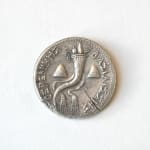Silver Coin Minted Under Ptolemy III Euergetes, 246 BCE - 221 CE
Silver
height 4.4 cm
height 1 3/4 in
height 1 3/4 in
C.4000
Obverse, veiled and diademed bust of Berenike II, wife of Ptolemy III, in right profile, hair shown in striations; pellet border, surrounding; reverse, BERENIKES BASILIKES (Berenice Queen) either side of...
Obverse, veiled and diademed bust of Berenike II, wife of Ptolemy III, in right profile, hair shown in striations; pellet border, surrounding; reverse, BERENIKES BASILIKES (Berenice Queen) either side of cornucopia bound with fillet between caps of Dioskouroi. Ptolemy III Euergetes (Benefactor) came to the throne of Egypt in 246 BC. An energetic ruler, he carried the Ptolemaic kingdom to its apogee as an international power. Extensive military campaigns kept him away from Egypt and it is likely this issue, minted in the name of his wife Berenike II, belongs to the period he was on campaign in Seleukid territory, 246-241 BC. Coin portraits of queens were common in Hellenistic Egypt, where women had higher status than elsewhere in the ancient world. Berenike is depicted with the royal diadem and a veil. The fruit-filled cornucopia is a symbol of abundance and prosperity often depicted on the coins of agricultural Egypt. It has been suggested that the Dioscuri caps could refer to the famous apotheosis of “the lock of Berenike,” a lock of hair sacrificed by the queen to ensure the safe return of her husband from the Syrian wars, which supposedly was taken to heaven by the Dioscuri and became the constellation Coma Berenikes.
A rare and impressive coin that has been subject to much discussion in recent years. Please see ‘The Journal of the Society for Ancient Numismatics (SAN XX, No. 1)’ by David Vagi & ‘Ptolemaic Coins: An Introduction For Collectors’ by R.A. Hazzard, for more details.
A rare and impressive coin that has been subject to much discussion in recent years. Please see ‘The Journal of the Society for Ancient Numismatics (SAN XX, No. 1)’ by David Vagi & ‘Ptolemaic Coins: An Introduction For Collectors’ by R.A. Hazzard, for more details.



